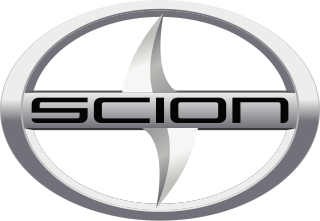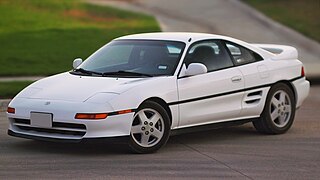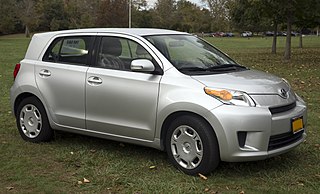
The Toyota Celica is an automobile produced by Toyota from 1970 until 2006. The Celica name derives from the Latin word coelica meaning heavenly or celestial. In Japan, the Celica was exclusive to the Toyota Corolla Store dealer chain. Produced across seven generations, the Celica was powered by various four-cylinder engines, and bodystyles included convertibles, liftbacks, coupés and notchback coupés.

Scion was a marque of Toyota that debuted in 2003 and was available only in the United States and Canada. The marque was intended to appeal to younger customers, the Scion brand emphasized inexpensive, stylish, and distinctive sport compact vehicles, and used a simplified "pure price" sales concept that eschewed traditional trim levels and dealer haggling; each vehicle was offered in a single trim with a non-negotiable base price, while a range of dealer-installed options was offered to buyers for personalizing their vehicles. The Scion name, meaning the descendant of a family or heir, refers both to the brand's cars and their owners. In an effort to target millennials, Scion primarily relied on guerrilla and viral marketing techniques.

The Toyota MR2 is a line of two-seater, mid-engined, rear-wheel-drive sports cars, manufactured in Japan and marketed globally by Toyota from 1984 until 2007 over three generations: W10 (1984–1989), W20 (1989–1999) and W30 (1999–2007). It is Japan's first rear mid-engined production car.

The Toyota Vitz is a subcompact car produced by the Japanese automobile manufacturer Toyota from 1999 to 2019 in a three- or five-door hatchback body styles. The "Vitz" nameplate was used consistently in Japan, while most international markets received the same vehicle as the Toyota Yaris, or as the Toyota Echo in some markets for the first generation. The Vitz was available in Japan from Toyota's Netz Store dealerships. Toyota began production in Japan and later assembled the vehicle in other Asian countries and in France.

The Scion tC is a compact car manufactured by Toyota under its Scion brand from 2004 to 2016 over two generations: ANT10 (2004–2010) and AGT20 (2010–2016). Both generations were built in Japan. The tC was introduced first in the United States for the 2005 model year and then, beginning with the second generation in the 2010 model year, in Canada as well. The tC was Scion's best-selling model, constituting almost 40% of total Scion sales.

The Scion xB is a compact car made by Scion, a now-defunct fully owned division of Toyota, for the United States market. It is a box-shaped, 5-door hatchback.

The Toyota Yaris is a supermini/subcompact car sold by Toyota since 1999, replacing the Starlet and Tercel.

The Toyota Platz is a subcompact car that was manufactured in Japan by Toyota from 1999 until 2005, when it was replaced by the Belta. Designated by Toyota as the XP10 series, the Platz was also sold in export markets as either the Toyota Yaris or Toyota Echo. The "Yaris" and "Echo" names were also given to the export version of the related Japanese market Vitz hatchback, from which the Platz derives. In Japan, it was available at the Toyopet Store and the Netz Toyota Store dealerships.

The Toyota bB is a mini MPV produced by the Japanese car company Toyota. The first generation launched in 2000, and the second generation was jointly developed with Daihatsu from 2005.

The Toyota Ist is a subcompact car manufactured by the Japanese automaker Toyota. It is exported to the United States as the Scion xA and Scion xD, the Middle East as the Toyota xA and to Europe and Latin America as the Toyota Urban Cruiser for the second generation.

The WiLL brand was a marketing approach shared by a small group of Japanese companies who decided to offer products and services that focused on a younger demographic from August 1999 until July 2004 in Japan. The companies that participated were the Kao Corporation, Toyota, Asahi Breweries, Panasonic, Kinki Nippon Tourist Company, Ltd, Ezaki Glico Candy, and Kokuyo Co., Ltd.. Toyota also engaged in a similar "youth oriented" approach in North America, with the Project Genesis program. This selective marketing experiment reflected a Japanese engineering philosophy called Kansei engineering, which was used by other Japanese companies. All products were listed online at "willshop.com".
Shigeyuki Hori is the principal designer of Toyota's acclaimed Hybrid Synergy Drive hybrid motor system which is in use by several vehicles including the Prius and Lexus RX Hybrid. An executive chief engineer in Toyota Motor Corporation, Dr. Hori served as chief engineer for more vehicles simultaneously than any other person in the company's history, by taking charge of the Prius, Celica, MR2, Caldina, Opa, Avensis, and Scion tC development efforts in the early to mid-2000s.

The Scion xD is a subcompact hatchback that was marketed in the U.S. and Canada by Japanese manufacturer Toyota beginning with the 2008 model year, as a five-door subcompact hatchback — replacing the xA. The Scion xD and the second generation xB were first shown to the public on February 8, 2007 at the Chicago Auto Show.
The Toyota NBC platform is an automobile platform for subcompact cars from Toyota. "NBC" stands for "New Basic Car" or "New Basic Compact". The NBC platform made its debut in January 1999 with the first generation Vitz; as such, it is also called the "Vitz platform". It is replaced by the newer B platform.

The Toyota Prius c (c stands for "city"), named the Toyota Aqua (Japanese: トヨタ・アクア, Hepburn: Toyota Akua) ("aqua" is Latin for water) in Japan, is a full hybrid gasoline-electric subcompact/supermini hatchback manufactured and marketed by Toyota. The Prius c is the third member of the Prius family, and combines the features of a Yaris-sized car with a hybrid powertrain. The Prius c is priced lower than the conventional Prius and has a higher fuel economy in city driving under United States Environmental Protection Agency test cycles. The Prius c was ranked by the EPA as the 2012 most fuel efficient compact car when plug-in electric vehicles are excluded.

Toyota Argentina S.A. is the Argentine subsidiary of Japan-based conglomerate Toyota, being also the first Japanese automotive company to produce in Argentina. Established in 1994, the company has its manufacturing plant in Zárate, Buenos Aires, which opened in 1997.

The automotive industry in the Philippines is the 9th largest in the Asia-Pacific region, with approximately 273.4 thousand vehicles sold in 2019. Most of the vehicles sold and built in the Philippines are from foreign brands. For the most part, the Philippines is dominated by Japanese automobile manufacturers like most of its ASEAN neighbors. The automobile production in the country is covered under the Philippine Motor Vehicle Development Program implemented by the Board of Investments. In addition, there are also a small number of independent firms who assemble and fabricate jeepneys and other similar vehicles, using surplus engines and drivetrain parts mostly from Japan.

Toyota vehicles in Japan are distributed to numerous dealership chains throughout the country. Up to May 2020, each dealership chain had a different product offering, with some models restricted to one chain to maintain exclusivity. Since May 2020, every Toyota model in Japan was available in all dealership chains. Current dealership chains include Toyota Store, Toyopet Store, Toyota Corolla Store and Netz Store.

The Mazda2 is a subcompact/supermini (B-segment) car manufactured and marketed by Mazda since 2002, currently in its third generation. An entry-level model of the brand in markets outside Japan, the Mazda2 is positioned below the Mazda3. The Mazda2 has also been marketed as the Mazda Demio, while its direct predecessor was exported as the Mazda 121.
















